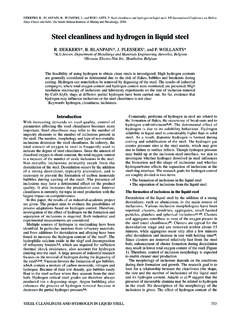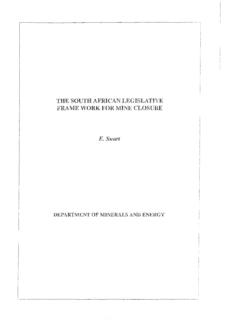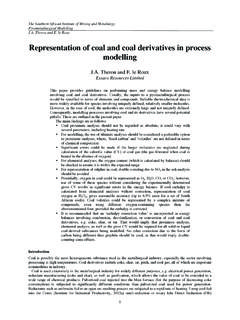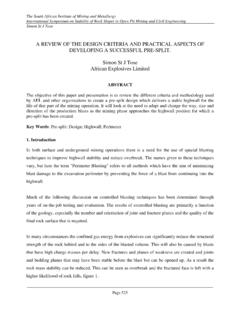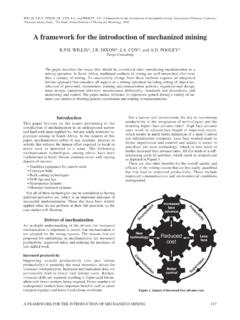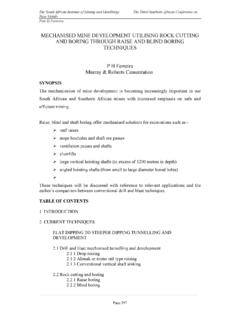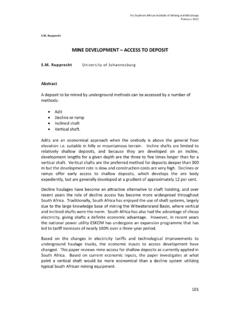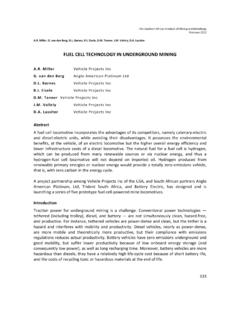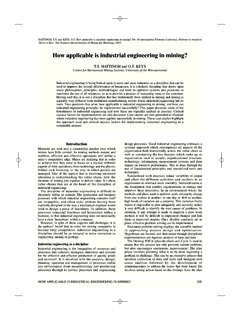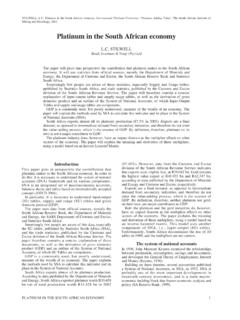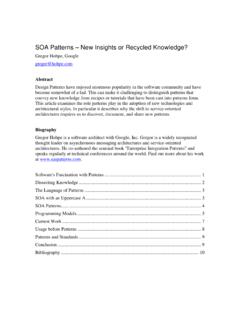Transcription of Design and development of a novel thickener feedwell using ...
1 IntroductionThickeners are a key unit in many hydrometal-lurgical processing operations for theseparation of solids and liquor. Flocculant isoften added to bridge the particles into large,fast-settling aggregates with the aim ofproducing a clear liquor overflow and aconcentrated underflow suspension of overflow is usually collected from theouter edge of the upper surface of thethickener, and the thickened underflow istypically removed (by pumping) through acentrally located drain at the base of nature of the flow structure in thefeedwells is of critical importance to theperformance of industrial thickeners, since it isgenerally here that most of the aggregationand energy dissipation processes occur. Theflow inside the feedwell is turbulent, with thecharacteristics and distribution of theturbulence having a major influence on theway the flocculant mixes through the slurry, aswell as on the particle aggregation processesand consequently the size and density ofaggregates that are feedwell should be designed to.
2 Dissipate the kinetic energy of the feedstream Provide sufficient residence time, feeddilution, mixing, and solids/flocculantdispersion to maximize the size of theaggregates formed through flocculation,while ensuring the effective capture ofthe fines Provide a uniform discharge pattern, tomaximize the use of the availablesettling area and to avoid inducingrecirculation patterns in the bulk of thethickener Cope with variations in the flow rate orsolids concentration of the feed slurry Be cost-effective and easy tomanufacture and part of the AMIRA P266 ImprovingThickener Technology series of projects(Fawell et al., 2009), a computational fluiddynamics (CFD) two-phase feedwell modelwas developed to investigate fluid flow, solidsDesign and development of a novel thickenerfeedwell using computational fluid dynamicsby Nguyen*, Farrow , J.
3 Smith , and Fawell SynopsisThe feedwell performance in gravity thickeners and clarifiers relieson the efficient mixing between solid particles and flocculant toachieve effective flocculation, as well as energy dissipation of theincoming feed stream. A population balance-computational fluiddynamics (PB-CFD) model has been developed and validated toprovide new insights into the operation and performance ofindustrial feedwells. In particular, the PB-CFD model enables theefficacy of the main functions of a feedwell to be investigated for awide range of feedwell designs and process paper describes how PB-CFD was used in the Design anddevelopment of a new feedwell concept for the flocculation ofparticles in a solid-liquid stream. The patented feedwell designincludes an upwardly converging flow diverter to create twoseparate compartments for energy dissipation and simulations of this simple and easy-to-retrofit feedwelldesign illustrate a superior performance in terms of flocculation andenergy dissipation compared to typical feedwells over a wide rangeof flow conditions.
4 The potential benefits include reduced flocculantconsumption, better de-aeration, greater stability and the ability tocope with a wider variation in volumetric throughput, better floccu-lation and fines capture, and a more symmetrical discharge thatmay also offer improved overflow clarity in some new feedwell Design has been installed in a full-scalethickener at an Anglo American Platinum site in South Africa. Anumber of operational factors complicate this application, butindications are that the new feedwell has led to improvements instability and underflow , feedwell Design , flocculation, energy dissipation,computational fluid dynamics, simulation.*CSIRO Mathematical and Information Sciences,Australia. CSIRO Process Science and Engineering, Australia.
5 Anglo American Mineral Processing, South Africa. The Southern African Institute of Mining andMetallurgy, 2225-6253. This paper wasfirst presented at the, 15th International Seminaron Paste and Thickened Tailings (Paste) 2012,16 19 April 2012, Sun City, South Journal of The Southern African Institute of Mining and MetallurgyVOLUME 112 NOVEMBER 2012 Design and development of a novel thickener feedwell using computational fluid dynamicsdistribution, and flocculant adsorption (Johnston et al., 1998;Kahane et al., 2002). The model has been enhanced with theincorporation of population balance (PB) capability to accountfor aggregate growth and breakage processes, flocculationkinetics. The PB-CFD thickener model has been developedbased on knowledge of the fundamental physical andchemical processes occurring within the feedwell , which hasbeen gained from a comprehensive range of experimentalmeasurements conducted on the laboratory, pilot scale, andfull scale (Nguyen et al.)
6 , 2006; Fawell et al., 2011).The CFD model has been used to test and evaluate newfeedwell Design concepts and to provide performancecomparisons with other common conventional designs. Onesuch Design concept is presented in this paper, along with anassessment of its full-scale descriptionA conventional steady-state Eulerian-Eulerian two phasemodel is used as the basis for the PB-CFD feedwell model,with the standard k- turbulence model acting in thecontinuous phase. The phases share a common pressurefield, with the momentum equations coupled via the inter-phase drag due to the liquid-particle slip. Implementation ofthe PB-CFD thickener model is in an ANSYS-CFX softwarepackage, with extensive use of additional customizedFORTRAN subroutines to include the population balance andextra physics.
7 Various details on the model equations andpopulation balance descriptions have been given in previouspublications (Nguyen et al., 2006; Mohanarangam et al.,2009).The PB-CFD thickener model is used to demonstrate thefeedwell performance of a new feedwell Design (termed the P266E feedwell ) against the three common feedwell designsshown in Figure 1: A 4 m open feedwell with a single feed inlet systementering the feedwell tangentially A 4 m open feedwell with an added shelf and a singlefeed inlet system entering the feedwell tangentially A 3 m closed feedwell with a single feed inlet systementering the feedwell the P266E feedwell Design , shown in Figure 2, anupwardly converging cone is positioned on top of a smallshelf inside the exterior feedwell shell, defining a first zonefor energy dissipation (between the shell and cone) and asecond zone for mixing and flocculation (between the coneand rake shaft).
8 The single feed inlet is located at the bottomof the first zone, just above the shelf, so that the feed streamis forced to flow upward as a swirling flow in the first zone,providing an opportunity for de-aeration. The flow continuesto circulate in the first zone above the top of the cone,dissipating energy before proceeding through the openingbetween the first and second zones. Flocculant can beintroduced at the entry to the second zone so that theaggregates formed in this area will continue to growundisrupted prior to exiting the feedwell . A standard set of process conditions (feed rate of 1 000 m3h-1and 5% w/v solids with a 20 g t-1flocculantdosage) was used as the baseline to illustrate the insight andunderstanding of various aspects of feedwell performanceusing the calculated quantities outlined in the followingsection.
9 The slurry was calcite (Omyacarb 20, d50approxi-mately 24 m) and the flocculant was a 30 per cent anionicacrylamide/acrylate copolymer flocculant with high and discussionPerformance indicatorsFrom the PB-CFD model output, a number of parameters orperformance indicators were calculated and used to evaluatethe performance of the four feedwell designs. They are: Average aggregate size at the feedwell exit used toindicate the size of the aggregates leaving the is used as a measure of the overall flocculationperformance 940 NOVEMBER 2012 VOLUME 112 The Journal of The Southern African Institute of Mining and MetallurgyFigure 1 Schematic of the conventional feedwell designs(a) Open feedwell (b) Open-with-shelf feedwell (c) ClosedFigure 2 Schematic of the P266E feedwell Dilution ratio or recycle ratio, which is defined as thevolume of fluid being recycled from the settling zoneback into the feedwell (natural dilution) divided by thetotal volume of feed Momentum dissipation ratio (MDR)
10 , defined as theratio of the exit momentum of the fluid leaving thefeedwell divided by the feed momentum entering theunit. It is calculated to show how much feedmomentum is dissipated by the feedwell and/orgenerated by the action of gravity in the feedwell Kinetic energy ratio (EDR), defined as the ratio ofkinetic energy of the fluid leaving the feedwell dividedby the total kinetic energy entering the unit. It iscalculated to reflect the effectiveness with which thefeed stream kinetic energy is dissipated by the feedwell Maximum shear rate at the feedwell exit is usually anindication of the level of aggregate breakage at the this value exceeds 150 s-1, significant breakage ofthe flocculated aggregates would be performanceResidence timeFeed particles need only a short period of time to flocculateand grow to large sizes after coming into contact withflocculant, usually less than 10 seconds in a reasonably wellmixed feedwell .
